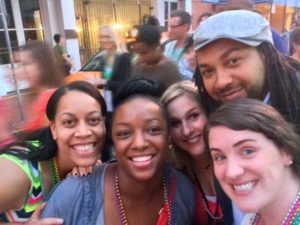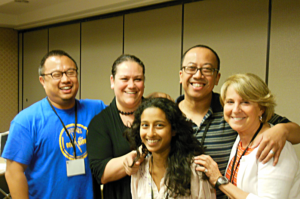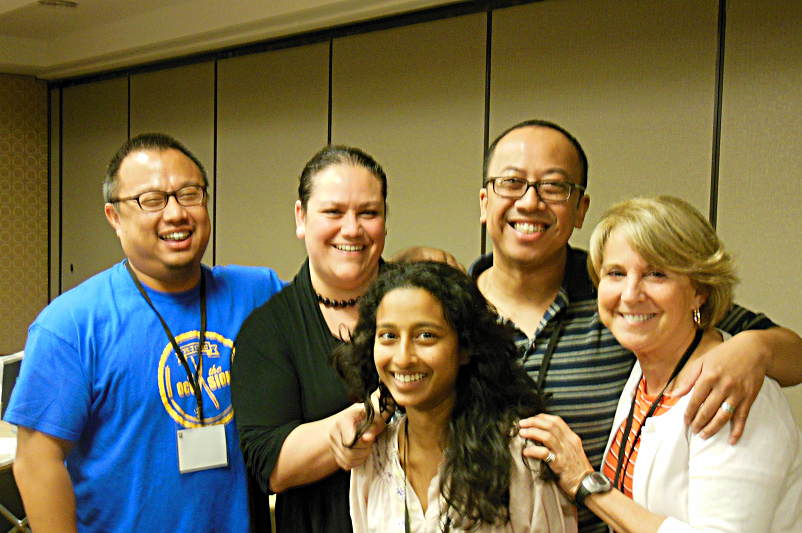Susan Sullivan, Brent Christie, Kelly Jones, and Charlotte Anthony share their thoughts on attending the Courageous Converastions Summit.


I am white
Susan Sullivan, board member of Eastside Pathways
Black. Brown. Red. Yellow. White. These are the labels we use to describe people’s skin.
Last month, I attended a conference, the National Summit for Courageous Conversation. It was a five day, deep dive on racial equity in education.
As a white person, I have avoided workshops on white privilege and racial equity. I assumed there would be a lot of blame and shame and frankly, I just didn’t want to take that on. The Courageous Conversation work by the Pacific Educational Group feels different to me. Yes, I am learning about racism and the part I play in perpetuating it, but I find the approach very constructive and forward-looking.
I have always thought of myself as racially aware, and I’ve worked to treat everyone the same. At the Beyond Diversity 1 workshop, which I attended last summer, I came to know that I really had no idea what it was like to be a black, brown, yellow, or red person. Nor did I understand the daily, subtle acts that crush the soul of those very same people. As a white person, I have never been followed in a store by security. This happens to people of color ALL THE TIME! As a white person, I have never been held up as a good/bad example of my race. As a white person, I can be outspoken, loud, and even rude, without putting my race on trial.
I continued with the Beyond Diversity 2 workshop last week. Through the Beyond Diversity training, I am exploring the experiences that brought me to where I am and my current perspective on race. I am learning how to look ahead and use my new understanding of racial equity to better support every child in Bellevue.
I will struggle with my discomfort and fear of doing something wrong, of offending someone. I will use the terms black, brown, red, yellow, and white as a way to acknowledge and even honor a person’s identity. I will strive to fulfill the Personal Statement of Racial Equity Purpose that I wrote in the workshop:
“As a white woman, I will develop a deeper understanding of race and institutional racism to eliminate the opportunity disparities for children of color in my community. I will face my fears of failure and lack of experience and knowledge by working with a diverse team of allies that are passionate and committed to long-term change and that will hold me accountable for both my privilege and my practice.”
Walk with me.
Becoming Aware of Being Unaware
Brent Christie, executive director of Jubilee REACH
Race. It tends to be a “hot button” issue, perhaps the most explosive issue in our society. Interracial conversations about race and racism can be very uncomfortable, socially awkward, even a bit dangerous, as latent emotions, perceptions, and pain become unmasked.
I thought I was ready, even eager, to engage in the racial conversation when I was invited by friends and partners within the Bellevue School District to participate in a five-day conference on race entitled Courageous Conversations. That’s five days among 900 racially diverse “strangers” from school districts throughout the country.
The first prerequisite for participation in the conference was that I “stay engaged.” No matter how personal or perilous the dialogue on race became, every participant was to stay engaged and remain committed to the conversation. The second related and requisite tenet was to “expect and experience discomfort.” I was about to discover, when unpacking my own and others’ perspectives and experiences about race, things were going to get uncomfortable. It didn’t take long.
Midway through my first day, each of us was asked to privately score “our truths,” based upon our race or color, in response to 26 statements about what we would consider normal, everyday life and social experiences. After totaling our personal scores, we were directed to silently line up around the room, highest scores to lowest. Without a sound, my group of 250 diversely mixed people became segregated, according to their racial “truth experience score.” White males formed the front of the line, then clustered with white females. From there the line extended from lighter to darker shades of brown, to black at the very end of the line. The silence was palpable. The visual became profound. Then, by a show of hands, our facilitator asked who had college degrees, master’s degrees, and PhD’s. Ultimately, more hands remained raised at the end of the line.
Discomfort. The conference called Courageous Conversations just got real. Voices began to speak. Voices of color spoke most, first from observations, then from inner thoughts and feelings, then from profound personal stories of real-life experiences. Polite turned to painful. The more personal, penetrating, and risky the conversation became, the more silent I, along with my white colleagues, became. Retreat to my white male comfort club was no longer a choice. My gut was churning.
For the next few days, face to face, in public, I was facilitated through a deeper dialogue. In smaller groups we unpacked. Through a persistent process of awkward, often gut-wrenching dialogue, I recognized how truly unconscious I was of my privilege. I realized that by being oblivious to my state of entitlement and privilege, I can actually irritate another person.
I absorbed stories from black and brown people, professionals with PhD’s, being pulled over by police being told: “you people take advantage of our rights…” I empathized with a highly educated black mother, coming to the defense of her children when a white school teacher insisted her 8-year-old son “didn’t belong,” demanding he be placed in special education classes. When that well-educated black mother became upset and persistent, she was dismissed as “irrational and angry” and asked to calm down or be removed from the school.
At one point, using only eye contact, we were to select a person of a different race to engage in a directed one-on-one conversation. Earlier, I had observed a black woman speaking in session. I was drawn to her pleasant, thoughtful manner. Fortunately, we made eye contact at the same time and our gesture to one another sealed our mutual selection of each other to engage in a courageous conversation. I learned Bernadette was a PhD and school board trustee for one of the largest school districts in the country. Upon learning I was from the Seattle area, Bernadette explained how she loved Nordstrom. Then she shared her truth, “When I shop at Nordstrom, I always dress well, because I have learned that when I dress casually, I’m looked at differently and I don’t receive service or attention.”
Bernadette said that she would be leaving the conference early to tend to a civil unrest issue in her district over a video that had gone viral. The video was of her! She explained how she had challenged the stance of her white male superintendent on a racial matter at her school board meeting. As she left the meeting, the superintendent, who happened to be a white male, had arranged for police to forcibly arrest her as she departed the building after the meeting. I later watched the YouTube video in disbelief. Now knowing Bernadette, I was angry.
The third tenet of Courageous Conversations required that I “speak my truth,” not try to pass off my own thoughts or assumptions as “some people.” I must own my own thoughts, feelings, and opinions without fear of offending, appearing angry, or sounding ignorant and not try to pass them off as “some people think…”
The fourth and final tenet was to “expect and accept a lack of closure.” Conversations about race usually provide no resolution, but they can perpetuate a process of learning, understanding, even appreciation and perhaps empathy.
Intense. That is one way of describing my truth of five days of Courageous Conversation in New Orleans. I certainly became aware of how unaware I was. Unaware and unconscious of the liberties, privileges, even entitlements being a white male affords me in our society. Douglas Fitch, a Methodist pastor wrote, “We see things not as they are, but as we are.” Because I have never experienced being a person of color in school, living in a white culture, entering the workforce or pursuing a career, I realize that many of my beliefs on race are based on misconceptions.
I also realized, that for racial conditions to change, it is not my role to play “savior” or be the big white fix. Rather I must be the change. I must be culturally competent and conscious, acknowledge the advantages that accrue to people based on skin color and socio-economic class, and deconstruct the barriers and bias that assume there is something wrong with people based on their racial or ethnic makeup. I must be the change I want to see, stay engaged, experience discomfort, speak my truth, and expect and accept this is not going to be easy. I must get comfortable with discomfort.
And to Bernadette, on the chance that you may ever read this, I want to say “thanks.” Thank you for speaking your truth to me, for connecting your eyes with mine, allowing me to hear your truth and see your heart as a mother, a courageous leader, and a friend during an intense week of personal discovery.
We Have to Talk About This
Kelly Jones, data officer at Eastside Pathways.
The Courageous Conversations summit was not the first time I recognized my own whiteness. It was just the first time I really stopped to stare it square in the face and talk about it at length with other people.
I remember riding the subway during my college years in Philadelphia or walking into my local grocery store in south Texas and feeling immediately aware of being the only white person in sight. While that was certainly uncomfortable, I knew that being a “minority” in those settings in a numeric sense was different in an important way from what people of color experience. I couldn’t verbalize how or why, and I never shared that feeling out loud with anyone.
The greatest gift I took away from the summit was a rough skill set for starting to engage in these conversations. I’ve begun to unpack the nuance of how race impacts the way I see the world and the way it sees me. The Courageous Conversations model is designed to achieve equity in schools, but it starts as a personal journey. It has to.
So why did being a white “minority” feel like an imperfect analogy to the experience of a person of color? Because it was. Because I live in a country where white is the default. In my life, being white has meant I am cognizant of my own race only on occasion. My whiteness does not often attract attention. My skin color is not the first adjective people use when they describe what I look like. My race does not follow me around like a shadow in retail stores, job interviews, or down the street at night, and it could very well purchase my safety in a split-second, life-or-death encounter with law enforcement or an armed vigilante. Being white is a protective shield I don’t even know I’m wearing. I ignore it because I can.
The privilege provided by my race became crystal clear on the second morning of the conference. The first news article I saw when I woke up was a column by Jerry Brewer in response to an analysis posted on The Bleacher Report. It had suggested that Russell Wilson might not be viewed as “black enough” by some of his teammates, including the recently departed Percy Harvin, to lead the Seahawks effectively as quarterback.
I can’t speak for how Russell felt about hearing that kind of comment. I haven’t been there. But that’s really the point, isn’t it? Nobody would ever question whether I am “white enough” to do my job.
The value of being able to talk about race was immediately clear; I couldn’t wait to bring this issue to my new friends at the conference and hear their thoughts. Since it was Sunday, I put my Wilson jersey over the back of my chair (like any good 12th Man at a conference on game day) and started talking.
Two of my tablemates were black men themselves. After I described the article, one of them said, “Well isn’t that timely,” to which his colleague responded, “No, it’s not timely—it happens every damn day. She’s just going to notice it more now.”
I do notice it more now. In fact, I see it almost everywhere. I want to keep talking about it.
The summit gave new meaning to Justice Sonia Sotomayor’s dissent in the Michigan affirmative action case earlier this year. She wrote that “the way to stop discrimination on the basis of race is to speak openly and candidly on the subject of race,” in contrast to a 2007 opinion by Chief Justice John Roberts that “the way to stop discrimination on the basis of race is to stop discriminating on the basis of race.”
When I see the choice put in such stark terms, I know where I fall. My journey is just beginning and will continue to be difficult. I see many days ahead when I stick my foot in my mouth or have to recognize some difficult truths about myself, my friends and family, and the nation I love.
But I am done being quiet about race. In a world where each week brings a new Michael Brown, Tamir Rice, Jordan Davis, Renisha McBride, or Trayvon Martin, what’s the alternative?
Moving Towards Racial Equity
Charlotte Anthony, communications and admin. associate at Eastside Pathways
As part of an effort to learn more about how to move towards racial equity as a community in Bellevue, the Eastside Pathways Team, along with several individuals from the Bellevue School District and Jubilee REACH, attended the 2014 National Summit for Courageous Conversations in New Orleans.
During the summit, teams engaged in a deepened conversation about systemic racism and the impact that it has on student opportunity and achievement.
For me, the summit was interesting because it was the 60th year anniversary of Brown v. Board of Education. The thoughts that came to my head were immediate, why are we still talking about racism and racial disparity in 2014? Shouldn’t we have solved this already?
“We cannot solve in 60 years what took 300 years to develop,” said Andrea Johnson, the lead facilitator of the Beyond Diversity training at the summit.
Her words rang with me throughout the training as it became clear to me that people were at different stages in their understanding of race in America.
At the conference, we had a surprise guest, Ms. Ruby Bridges. Bridges was the six-year-old girl who was selected to enter an all-white school after Brown v. Board. I was shocked by her story. She explained that her parents did not tell her the significance of the day, but advised her to be on her best behavior.
She did not understand the crowd waving signs and why they were there. She only knew that she was going to a new school. She explained that for a year she was taught in a separate classroom with a white teacher from Boston and she was curious when she heard voices of other children but could not find them. The teacher, knowing that keeping her in a separate classroom away from other children was not the intent of Brown v. Board of Education, went to speak with higher officials.
When she was allowed to see the other children, a white male student called her an offensive word. Ruby explained that it was on that day that she realized why she was kept in a separate classroom: she learned she was different because of her color of her skin. She also realized that she couldn’t judge people by the color of their skin because the boy was white, but her teacher was very nice to her and was also white.
Her story held significant impact for me because it reminded me of the first time when I realized I was of a different race. That awakening is something that can’t really be taught and after that moment, it can’t be untaught.

